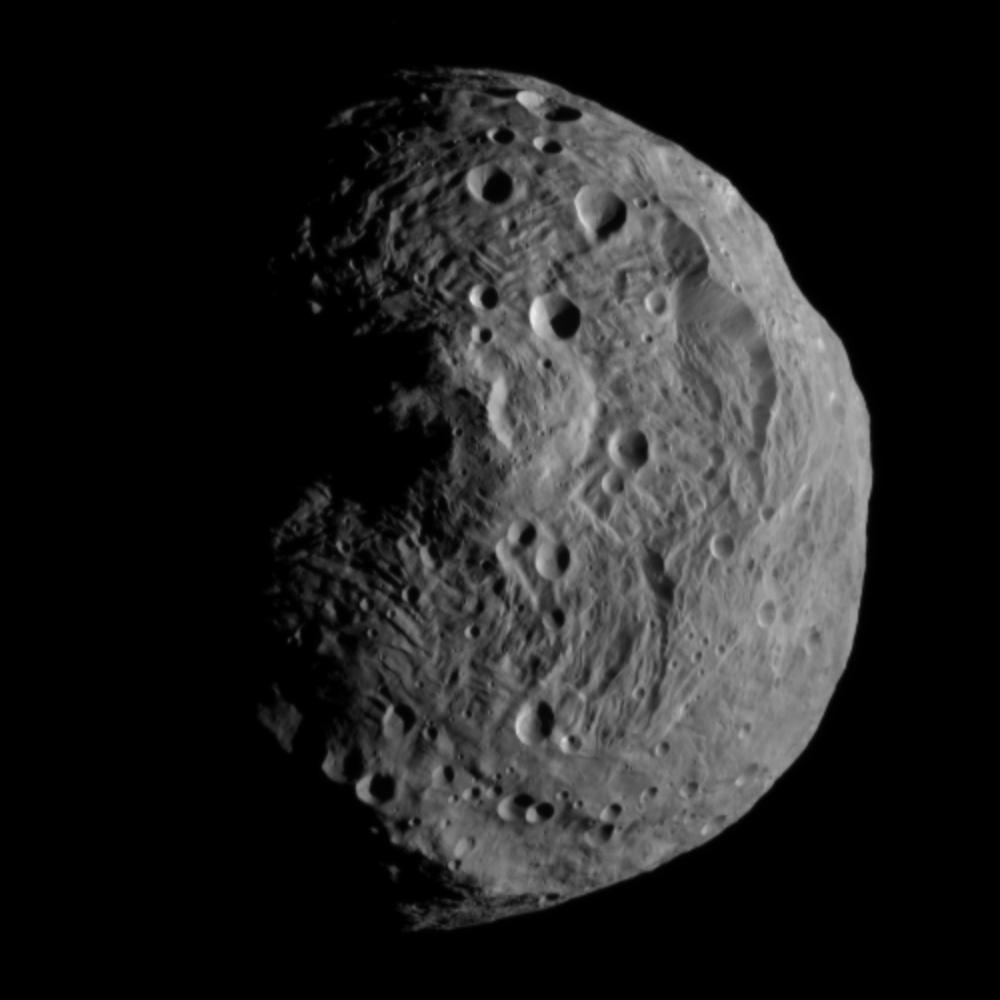
The NASA Dawn spacecraft’s close-up study of the giant asteroid Vesta is offering researchers their first look at the elemental composition of this ancient protoplanet. Vesta is the second most massive body in the main asteroid belt and has remained intact since its formation more than 4.5 billion years ago. Dawn’s Gamma Ray and Neutron Detector (GRaND) will determine the chemical composition of Vesta, providing new information about how Vesta formed and evolved. Tom Prettyman, a Senior Scientist at the Planetary Science Institute, is the lead for GRaND as well as Dawn’s Geochemistry Team.
The NASA Dawn spacecraft has been acquiring science data in orbit around Vesta since July of 2011. In December, Dawn reached its lowest altitude orbit, with an average distance of about 130 miles from Vesta’s surface. Vesta’s diameter is about 330 miles, just a little bit larger than the width of Arizona. Dawn plans to stay in this orbit for 110 days before ascending to higher altitudes and departing to its next destination, the dwarf planet Ceres.
At low altitudes, GRaND is detecting strong neutron and gamma ray signals that we will analyze to map the elemental composition of the entire surface of Vesta, Prettyman said. Unlike Dawn’s framing camera and visible and infrared mapping spectrometer, GRaND can see in the dark, Prettyman added. Consequently, GRaND is sensitive to the composition of Vesta’s surface at high northern latitudes, presently in polar night.
GRaND measures the abundance of elements found in planetary surfaces, such as hydrogen (H), iron (Fe), magnesium (Mg) and silicon (Si). The data will help scientists determine how hydrogen was delivered to the surface of Vesta – for example, by the solar wind or by carbon-rich materials hitting the asteroid. Measurements of rock-forming elements, including Fe, Mg, and Si, will help them understand the volcanic processes that shaped Vesta.
After five weeks of mapping in the spacecraft’s low altitude orbit, global-scale variations in Vesta’s elemental composition are apparent, Prettyman said. Vesta’s varied surface distinguishes it from smaller asteroids, which are typically uniform in composition. Vesta, which underwent complex geochemical processes, forming a core, mantle, and crust, seems more like a terrestrial planet than an asteroid.
GRaND’s initial observations are tantalizing; however, their interpretation will require additional accumulation of data and further analysis by Dawn’s Geochemistry Team. First results will be reported soon after mapping at low altitudes is complete.
Prettyman is lead author of a paper titled “Dawn’s Gamma Ray and Neutron Detector,” published recently in the journal Space Science Reviews as a chapter in a book about the Dawn Mission. The paper provides a detailed description of GRaND, including science objectives, design and construction, and measurement capabilities. Data acquired by GRaND will be made available to the public through the Planetary Data System’s Small Bodies Node. The paper will be a valuable resource for scientists who want to study the chemical makeup of Vesta.
PSI’s William Feldman, Jeffrey Morgenthaler, Karly Pitman and Robert Reedy are among the paper’s co-authors. PSI’s Naoyuki Yamashita, a veteran of the Japanese mission Kaguya, recently joined the GRaND team and is helping to analyze the data acquired at Vesta.
GRaND is operated by the Planetary Science institute under the leadership of Senior Scientist Tom Prettyman, who is also the lead for Geochemistry on Dawn. This work is supported by NASA under a subcontract from the Jet Propulsion Laboratory to the Planetary Science Institute. GRaND was built by Los Alamos National Laboratory under Prettyman’s direction and supervision.
The Dawn mission to Vesta and Ceres is managed by the Jet Propulsion Laboratory for NASA’s Science Mission Directorate, Washington, D.C. It is a project of the Discovery Program managed by NASA’s Marshall Space Flight Center, Huntsville, Ala. UCLA is responsible for overall Dawn Mission science. Orbital Sciences Corporation in Dulles, Va. designed and built the Dawn spacecraft.
More information: Information about Dawn is available at:http://www.nasa.gov/dawn
Planetary Science Institute
Source: PhysOrg.com
No hay comentarios:
Publicar un comentario